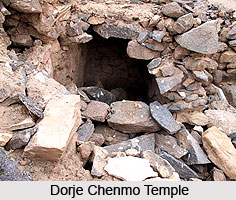 Dorje Chenmo Temple is located in Shey, a historic village in Leh district of Jammu & Kashmir. The presiding deity is known as Dorje Chenmo. This Buddhist temple is celebrated for its exquisite wall paintings, believed to be more than 350 years old. The collections include some exceptional paintings of divinities such as Dhyani Buddha, Avlokkiteshwara, Guru Padmasambhava, Paldan Lamo and Dorje Chenmo. These paintings are now focus of a conservation project conducted by UNESCO and Namgyal Research Institute on Ladakhi Art and Culture (NIRLAC), with vigorous support from the local residents.
Dorje Chenmo Temple is located in Shey, a historic village in Leh district of Jammu & Kashmir. The presiding deity is known as Dorje Chenmo. This Buddhist temple is celebrated for its exquisite wall paintings, believed to be more than 350 years old. The collections include some exceptional paintings of divinities such as Dhyani Buddha, Avlokkiteshwara, Guru Padmasambhava, Paldan Lamo and Dorje Chenmo. These paintings are now focus of a conservation project conducted by UNESCO and Namgyal Research Institute on Ladakhi Art and Culture (NIRLAC), with vigorous support from the local residents.
This article is a stub. You can enrich by adding more information to it. Send your Write Up to content@indianetzone.com





















